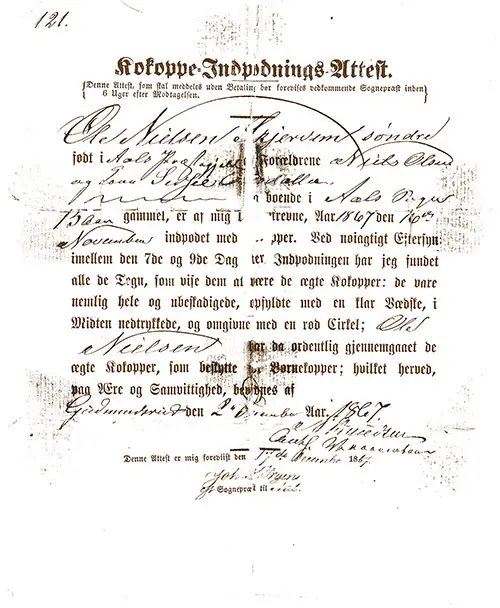1867 Cowpox Inoculation Certificate: Early Vaccination & Immigration Health Policies
Explore a rare 1867 Cowpox Inoculation Certificate, a critical document in early public health and immigration history. Learn how smallpox vaccination shaped migration policies, influenced steamship travel, and laid the foundation for Ellis Island medical screenings.
🩺 1867 Cowpox Inoculation Certificate: A Vital Record in Immigration & Public Health History
This 1867 Cowpox Inoculation Certificate for Ole Nielsen Skjervem is a fascinating historical artifact that illustrates the importance of early vaccination records in the context of immigration, public health, and genealogy. The document provides crucial details about the vaccinated individual, including their name, parents' names, age, location, and confirmation of successful inoculation against smallpox.
For teachers, students, genealogists, and historians, this document serves as a valuable primary source offering insight into:
✅ Early vaccination practices and their role in controlling smallpox, one of history’s deadliest diseases.
✅ Medical documentation required for travel and immigration, later evolving into mandatory health screenings at Ellis Island and other ports.
✅ The importance of inoculation in shaping public health policies, particularly for migrants and seafarers.
Kokoppe Indpodnings Uttest (Cowpox Innoculation Certificate) for Ole Nielsen Skjervem, 1867. GGA Image ID # 2220043ea9. Click to View a Larger Image.
This is a vaccination certificate that provides information on the 15 year-old person vaccinated, name of parents, age, and where they are from and the signer, in the year 1867 the 16th of November inoculated the person with cowpox.
After thorough examination between the 7th and 9th day after the inoculation, I have found all the signs that shows this to be proper cowpox. They are complete and unharmed, filled with clear liquid, In the middle depressed surrounded by a red circle.
/s/ Ole Neilsen
has then been through proper cowpox that guards against smallpox. This is with my honour and conscience testified at ??? on 2 December 1867.
This Uttest was presented to me on 17 December 1867, Parish priest to ?
/s/ Johan Trgens
Image Courtesy of Brian Vik, 2025.
📜 Why This Document Matters in Immigration & Public Health History
🔬 1. Early Vaccination Certificates: A Precursor to Modern Health Passports
This Kokoppe Indpodnings Uttest (Cowpox Inoculation Certificate) served as an official proof of immunization, ensuring that the individual was protected from smallpox—a disease that had caused devastating outbreaks in Europe and America.
Why It’s Important:
✔ Similar to today’s vaccination records and health passports (e.g., COVID-19 vaccination certificates).
✔ A necessary document for travel and migration, proving that the individual was safe to enter new communities.
✔ An example of how public health regulations influenced immigration policies, particularly in the 19th and early 20th centuries.
🛳 2. Smallpox & Immigration: The Connection to Steamship Travel & Ellis Island
By the late 19th century, steamship passengers were required to present proof of vaccination before embarking on transatlantic voyages. Immigrants arriving at Castle Garden (1854–1890) and Ellis Island (1892–1954) underwent rigorous medical inspections, including checks for smallpox vaccination scars as evidence of immunization.
Connections to Immigration History:
✔ Many European immigrants carried similar vaccination certificates, proving their eligibility to safely enter the U.S.
✔ Immigrants who lacked proper documentation risked quarantine or deportation.
✔ Public health laws directly influenced who could enter a country, shaping global migration patterns.
🌍 3. Smallpox: A Deadly Disease That Shaped Global Migration Policies
Before Edward Jenner’s discovery of the smallpox vaccine in 1796, smallpox epidemics killed millions worldwide. By the mid-1800s, vaccination programs were established in Europe and America to control outbreaks and protect travelers.
Why Smallpox Prevention Was Crucial for Migration:
✔ Highly contagious, smallpox posed a severe threat on ships carrying immigrants.
✔ Quarantine stations, such as Ward’s Island in New York and Grosse-Île in Canada, were established to isolate infected passengers.
✔ Mandatory vaccination helped reduce outbreaks, making immigration safer and preventing the spread of disease in port cities.
🖼 Noteworthy Images & Their Significance
📜 1. 1867 Cowpox Inoculation Certificate for Ole Nielsen Skjervem
👉 A rare historical example of early immunization documentation, proving the individual had received protection from smallpox.
✍ 2. Handwritten Confirmation by Parish Priest Johan Trgens
👉 Demonstrates the role of religious and medical authorities in verifying vaccinations before official record-keeping systems existed.
💉 3. Medical Description of the Vaccination Site
👉 Shows the level of detail used to confirm that the cowpox inoculation was successful—an early form of standardized medical reporting.
📖 How This Document Helps Teachers, Students, and Genealogists
📚 For Teachers & Students:
✔ A primary source for studying 19th-century public health policies and their impact on immigration.
✔ Cross-disciplinary use—relevant for history, biology, public health, and migration studies.
🔎 For Genealogists & Family Historians:
✔ If your ancestors immigrated in the 19th or early 20th century, they may have been required to show proof of vaccination.
✔ Similar documents may exist in family archives, particularly for Norwegian, Danish, Swedish, or German immigrants.
📝 For Historians & Researchers:
✔ Highlights early government efforts to control infectious diseases and ensure public health before the rise of modern epidemiology.
✔ Provides evidence of pre-immigration health screenings, which later influenced Ellis Island medical exams.
🔎 Final Thoughts: Why This Article Is Important
The 1867 Cowpox Inoculation Certificate is more than a medical record—it is a key piece of public health and immigration history that demonstrates how disease prevention shaped global migration policies. By requiring vaccination before travel, authorities helped reduce outbreaks and protect port cities—a concept that remains relevant today in global health policies.
🌍 This document serves as an essential reminder that health regulations have always played a role in migration, ensuring safer travel and helping to prevent the spread of infectious diseases.

